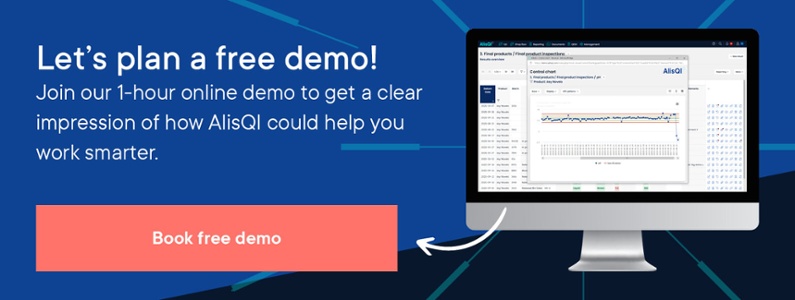Solvers help you monitor quality, apply SPC, manage equipment, and ensure traceability.

No-code QMS implementation paves the way to excellence and ROI
Manufacturers fear that digital transformation can be ruinously costly and disruptive, and businesses are right to be a little wary. Still, fear shouldn’t be a reason to use outdated systems or quality solutions that work ‘just well enough’. Picking out the right QMS platform, knowing what you can expect, and getting more bang for your buck makes navigating change so much easier.
A Quality Management System (QMS) is a smart decision and an important first step for your digital transformation. A QMS gives you insight into your data, makes deviations easier to correct and prevent, improves reporting, and has shopfloor operators engaged with quality through intuitive dashboarding.
The switch to digital can be quick and painless
Technology is advancing fast, and most manufacturers don’t know how to catch up. Despite relying on Excel spreadsheets and other ad hoc (often manual) solutions to track quality, they often imagine that even the switch to digital is complex and time-consuming. And, like it’s traditionally the case, they picture involving their already-too-busy IT department – which may postpone QMS deployment.
Cost, time-to-market, and agility are as important in Quality Management as they are in any other facet of business and manufacturing. The AlisQI no-code Quality Management System (QMS) can be implemented and adapted by the quality/operations team. It is not necessary to be a “techie”; if you can work with Google Docs and Excel spreadsheets, you’re good to go. No-code is gaining so much traction for precisely that reason: it gives autonomy to end-users. Our blog AlisQI: a no-code approach provides a lot more background to the no-code technologies and why they are ideally suited to Quality Management.
But what does the switch to quick and painless really mean? We see customers going live with their first processes within days of the start of the project. Next to speedy deployment, they enjoy greater flexibility as they are no longer dependent on the IT agenda. This means extensive involvement from the very beginning. “Playing around” is not an option if the implementation is in the hands of IT.
Because the end-users of the QMS are meaningfully involved, the results align with what is needed much more rapidly. “You get going in no time,” says a QESH manager. “The system is intuitive and robust. You try this, you try that, you play around with it, and before you know it, the platform is working exactly the way you want it to work.”

No-code implementation means full control
Implementation should not be a make-or-break obstacle to digital transformation, but often it is. Because of our no-code approach, AlisQI makes it simple to get started. Implementation – and customization – can largely be carried out by business users.
This was our conception from the outset: to build a QMS that was accessible and that would swiftly get buy-in from the factory floor as well as the boardroom. More than that: the platform had to put the quality professionals center stage, even if AlisQI or one of our partners helped them with the implementation project.
What AlisQI could not be therefore was a “blackbox” tool that required input from developers not immediately familiar with Quality Management workflows and processes – the implementation would not be optimal, and much slower.
All AlisQI customers reference ease of implementation. A QA manager and her colleague, both without IT experience, implemented the no-code platform themselves. “Anyone who has ever worked with Google can also work with AlisQI; it’s a very simple system, and easy to understand,” she says.
What’s the ‘damage’?
The AlisQI no-code platform pays for itself in just four months if you are an “average” manufacturer with a 50-strong workforce, 500 controlled documents, processing 300 QESH registrations a year, overseeing 100 QC inspections a week and generating a weekly average of 10 Certificates of Analysis. Of course, no manufacturer is exactly like that so we invite you to look at our ROI calculator to see how much time and money our no-code solution could save your business.
We didn’t pluck these figures out of thin air; they are not projections of what we think the figures ought to be but are based on the pooled experience of the manufacturers that are working with AlisQI.
But what about the implementation project? Surely there’s a bill to pay for implementing your QMS? Naturally, there is a cost – but it is so modest for all manufacturers and its impact on ROI so minimal, it has been absorbed in the calculations.
Implementation can already begin if manufacturers commit to a pilot project. This pilot is a fully-fledged project that aims to replicate 10%-20% of the existing Quality Management infrastructure. Because of no-code, end-users grasp the power and potential of AlisQI immediately. Halfway through configuring AlisQI for a pilot, one QA manager decided to press ahead with full implementation and signed a contract on the spot. “In March we ran AlisQI in parallel with our old Excel solution, and in April we went live,” he says.
The advantages of no-code extend beyond implementation of course, and that will be the subject of our next and final blog on our no-code approach: how you can maintain, adapt, and customize the AlisQI platform, and embed advanced business logic in your workflows and analyses.
A ROI tool cannot put a number on the benefits of a future-proof QMS, one that continues to add value long after the platform has paid for itself. Those benefits are incalculable.
Try our no-code platform and learn how it can transform your processes.


